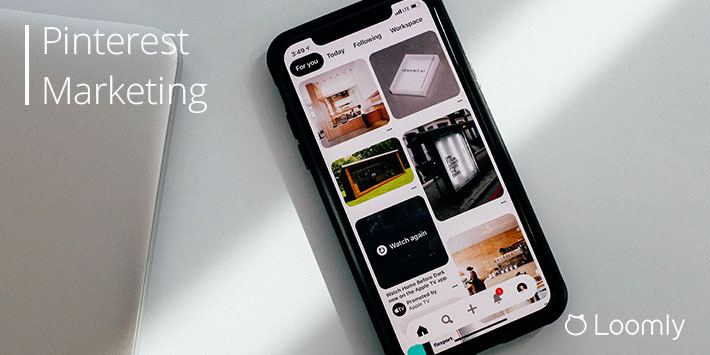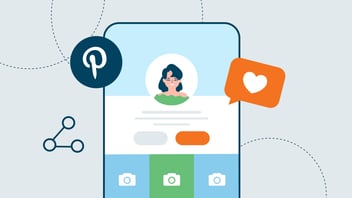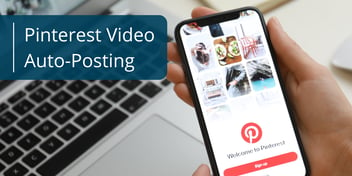For most experts, Pinterest is a dark horse — a platform that quietly & consistently overdeliver.
In 2020, while other more-fancied social platforms, such as TikTok and Clubhouse, were grabbing the headlines, Pinterest was coming up strong on the inside. In fact, it was second only to TikTok for growth.
Today, it’s established itself as a more powerful marketing platform for brands, especially with its streamlined, frictionless connection to ecommerce.
In this guide, you’ll discover why your brand should care about Pinterest and what makes it unique. Then, we’ll highlight some successful brands and show you how you can harness the power of Pinterest for your brand.
Let’s begin.
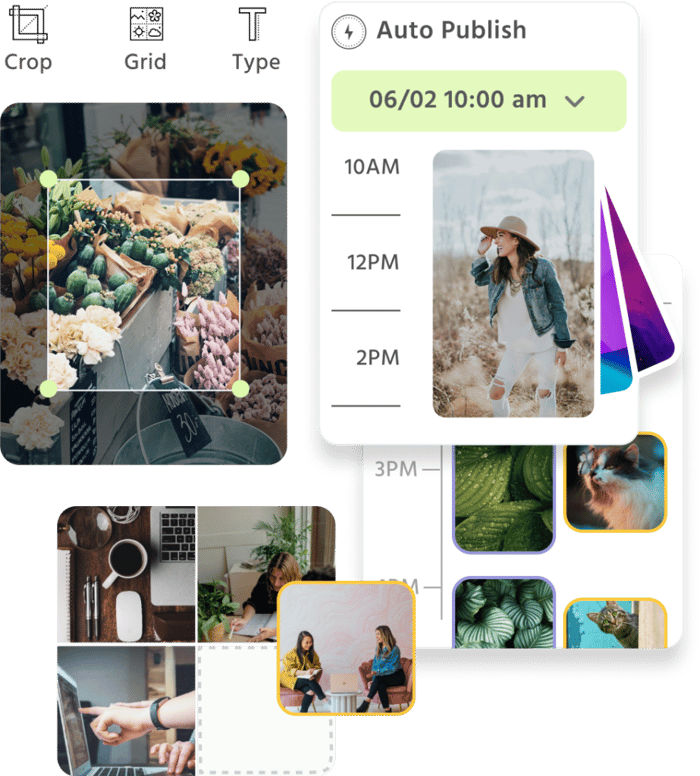
Manage all your social media accounts in one place.
Craft, schedule, & auto-post content to all your social channels, then track analytics and manage interactions from a single, easy-to-use dashboard.
Why Your Brand Should Care About Pinterest
According to Pinterest, there are three core reasons why you should take note of Pinterest:
- People are eager for new ideas, which means they want to hear from you. Use your content to inspire them. 97% of Pinterest searches are unbranded.
- People use Pinterest to plan for the future. You can reach them here before your competitors do. 85% of Pinners say they start a new project on Pinterest.
- Pinterest is where people browse, discover, and buy. You can take your audience from thought to action. 80% of weekly Pinners have discovered a new brand or product on Pinterest.
Pinterest usage stats
The latest figures from Pinterest reveal that 478 million people now use the platform every month to find ideas and inspire their next purchase. Currently, it’s the second-fastest growing social media platform only to TikTok:
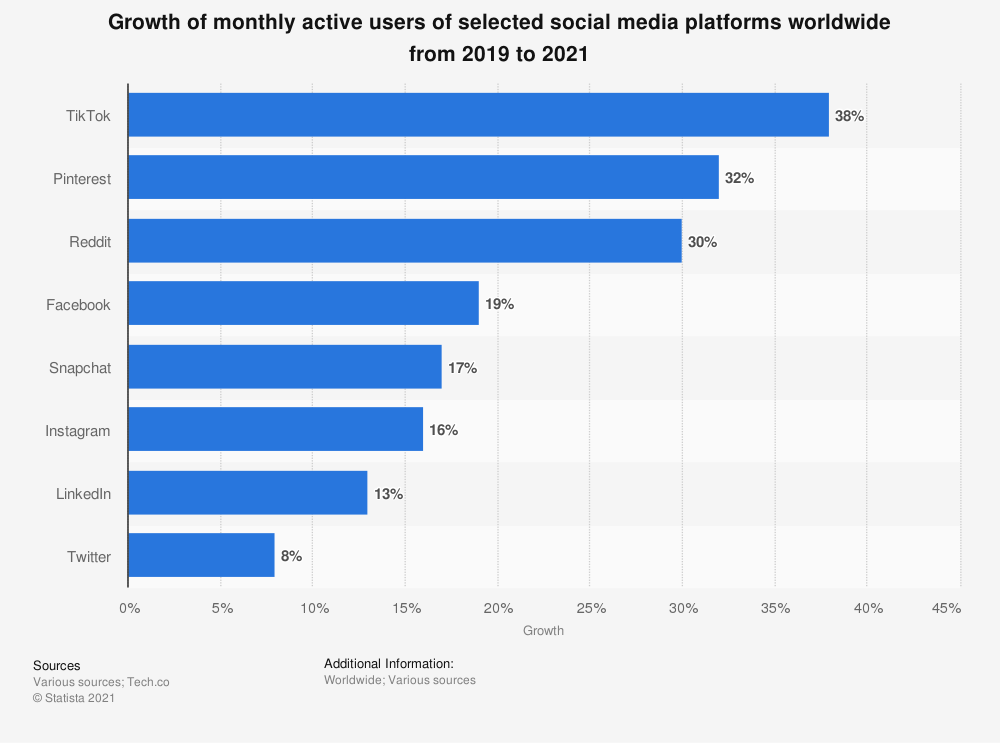
Pinterest demographics
Historically, there have always been more women than men using Pinterest. The latest figures reveal that women still make up more than 60% of the global audience. However, in 2020, the number of male Pinners increased by nearly 50%.
Plus, the number of Millennial users (anyone born between 1981 and 1996) grew by 35%, and the number of Gen Z users (anyone born after 1997) grew by 40%.
Most popular Pinterest accounts
According to Trackalytics, the most followed Pinterest accounts are:
- Ohjoy = 15M followers
- Maryannrizzo = 9M followers
- Poppytalk = 8.9M followers
- Bekkapalmer = 8.4M followers
- Cathiehong = 7.9M followers
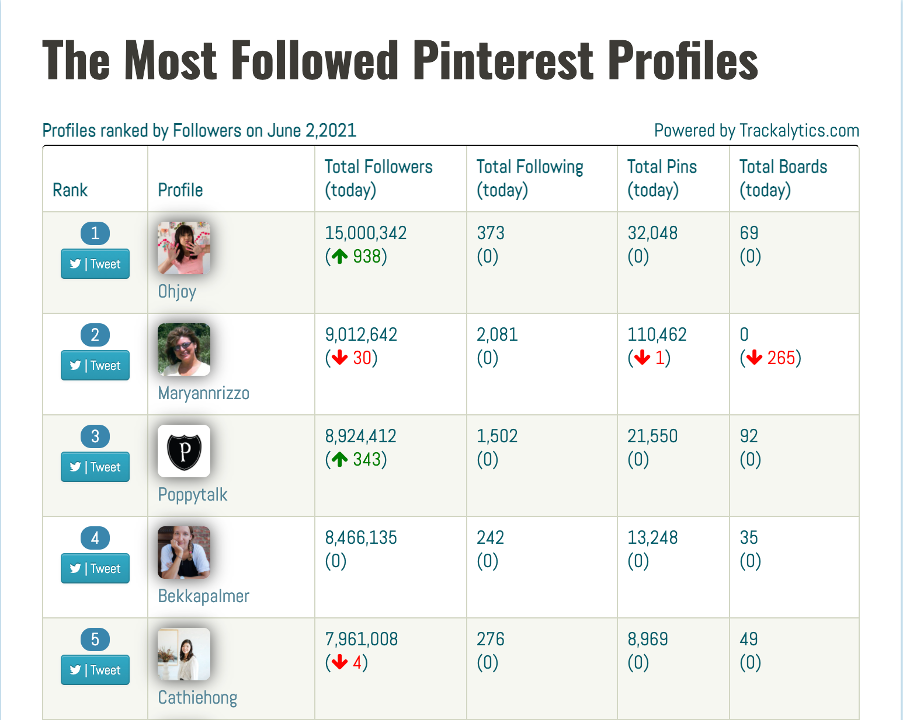
What Makes Pinterest Unique?
Pinterest is a unique platform with an equally unique business model that differentiates it from other photo-sharing websites. Instead of users sharing photos directly with friends, Pinners curate personal pinboards of existing images and videos uploaded by friends, strangers, and brands, as well as creating and uploading their own material.
Visual search engine
Pinterest is not just a social platform – it’s a visual search engine.
Like other social media networks, Pinterest is a place to connect with friends and influencers. But as a visual search engine and a “productivity tool for planning your dreams,” it also offers much more than that.
Pinners are searching for “Pinspiration.” They’re planning their weddings, dream vacations, and home decor. And because of that, they’re not only receptive to brand content—they find it helpful.
Optimizing your Pinterest marketing strategy for views and saves is much more effective than focusing on likes and comments.
SEO
Pinterest has its own algorithm and search engine optimization rules. You can optimize your Pinterest content in much the same way that you optimize your web content for search engines.
For example, you can add relevant keywords (aligned to your target audience) to your profile, pins, and boards.
Ecommerce
Given that Pinterest is an inspirational platform (revealed by its advertising performance), it’s no surprise that it drives a high volume of ecommerce traffic.
Research by Shopify found that:
- Pinterest was the #2 source of all referral traffic to their site.
- That 93% of users were using Pinterest to plan their purchases.
- The average resulting order value was $50 (higher than any other social media source).
Pinterest is geared up for brands to sell their products:
“Share a gorgeous catalog. Set up your storefront. And then get to the good stuff, like tracking conversions and measuring results.”
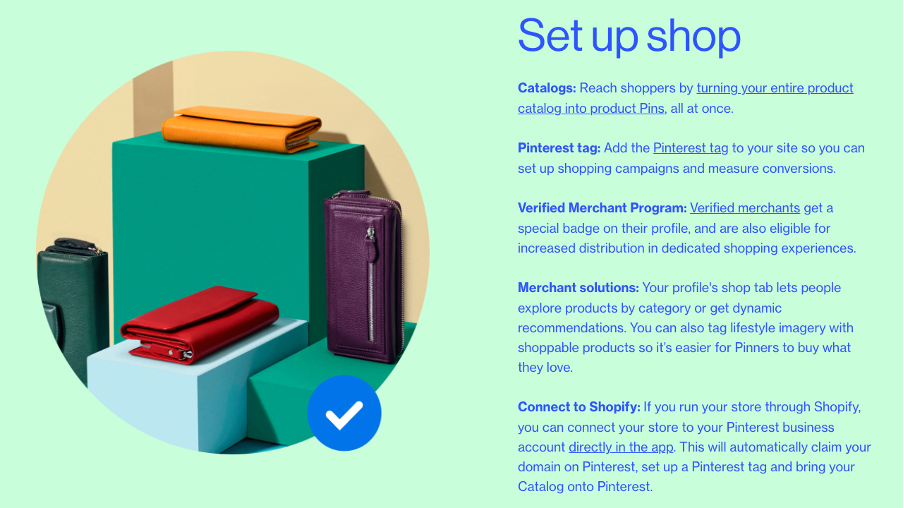
Longer shelf life
Compared to other social platforms, content shared on Pinterest has a much longer shelf life. When you create a Pin, you’re unlikely to be overwhelmed with likes and comments. But over time, your Pins will be discovered via search and saved many times.
Pinterest Pins live up to 1,600 times longer than posts on Facebook or any other platform:
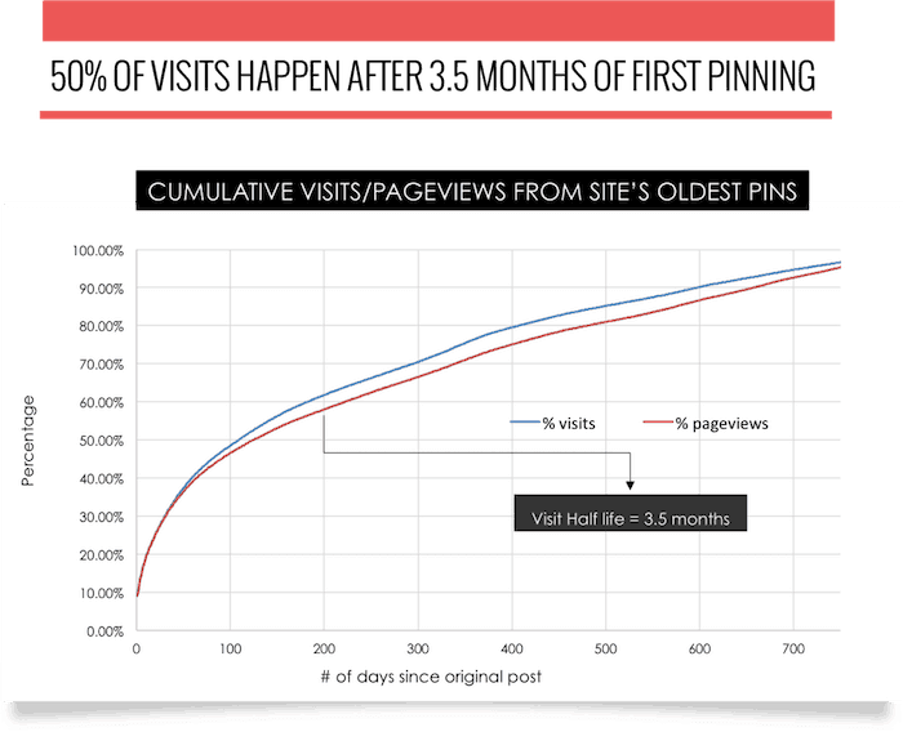
Examples of Successful Brands on Pinterest
Here are three examples of brands using Pinterest to increase ecommerce sales, drive website traffic, and boost Pinterest SEO.
Ruggable — Ecommerce strategy
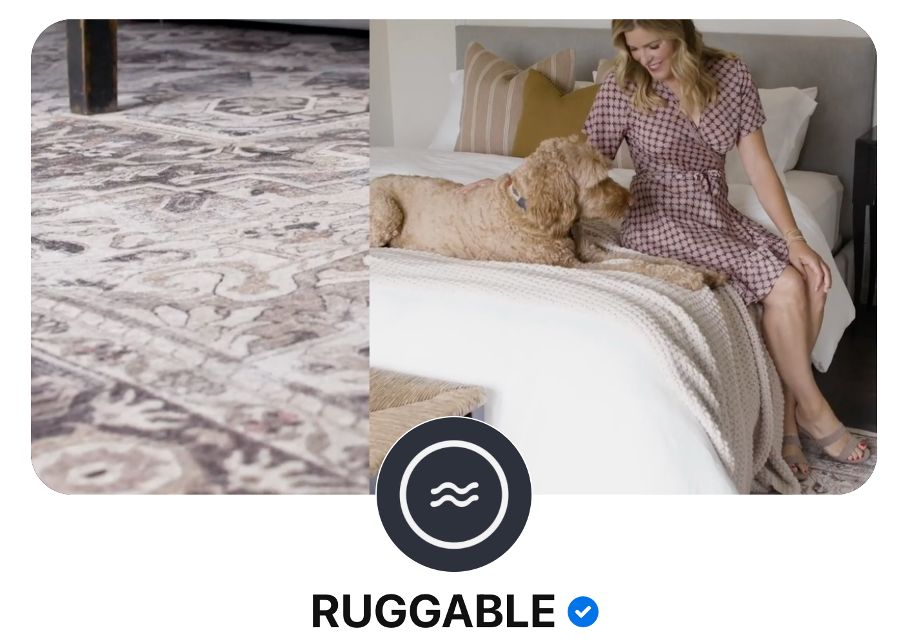
Ruggable makes machine washable rugs that are changeable, durable, spill-proof, and easy to clean.
They were one of the first brands to add the new Shop tab to their Pinterest profile. The Shop tab allows users to browse and shop in-stock product Pins from brands.
Ruggable’s Shop tab links their Product Pins directly to their ecommerce checkout page — removing purchase friction and increasing sales.
Whole Foods Market — Rich Pins for click-throughs
Whole Foods Market uses Rich Pins to help spread brand awareness and add more context to its blog posts.
The health-focused supermarket brand provides cooking information, offers real-time information on product availability, and sends Pinterest users to their blog posts.
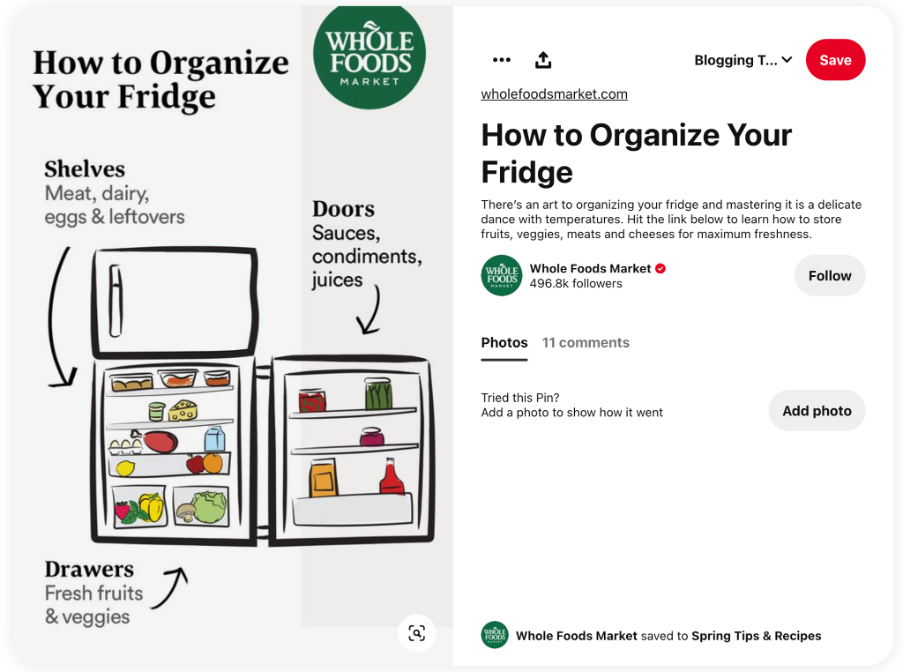
You can use rich Pins to drive more app downloads, link to your blog content, or send users directly to your ecommerce store.
Etsy — Pinterest board variety
Etsy has a wide variety of Pinterest boards based on popular categories and keywords from their ecommerce platform, like DIY Projects, Etsy Jewelry, and Home Decor.
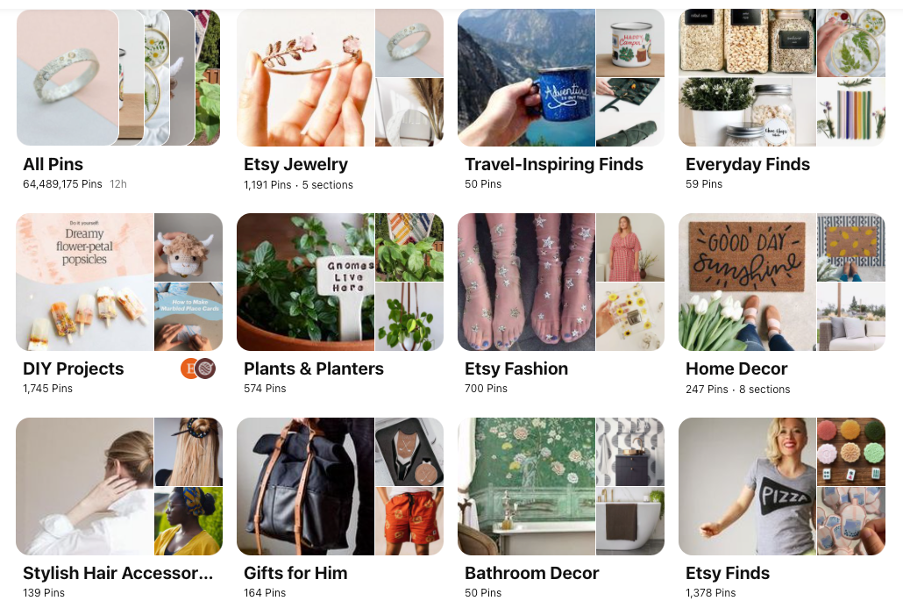
They also add board descriptions to help boost Pinterest SEO. For example, Etsy Jewelry reads:
“One-of-a-kind and personalized jewelry, all handmade. From stamped and custom necklaces, to statement earrings and raw gemstone rings, find beautiful jewelry only from Etsy.”
How to Harness the Power of Pinterest for Your Brand in 2021
Let’s take a look at how to get your Pinterest marketing off the ground with these six steps:
- Setting your goals
- Branding your profile
- Creating and optimizing your content
- Publishing your content
- Promoting your content
- Analyzing your results
Step 1. Setting your goals
As with any marketing strategy, you need to set goals that align with your overall business objectives. And by setting SMART goals, you can make them more specific. For example:
- Increase followers to 100 by the end of Q1.
- Generate at least five rug sales by the end of the month.
There are other Pinterest goals you may want to consider, such as:
- Building brand awareness and reaching more of your ideal customers.
- Showcasing your products.
- Growing an engaged community.
- Increasing brand loyalty.
You’ll circle back to these goals when you analyze your results.
Step 2. Branding your profile
Your Pinterest profile creates the first impression with visitors, so it’s essential to make it count.
If you have other social media profiles, then you’ll want to brand them in the same way so that users instantly recognize you. Plus, you’ll also want to ensure you create a business Pinterest account so that you have access to analytics, rich pins, and more.
Upload a profile image
Depending on your brand, you can either use your logo or headshot if you’re building a personal brand. Make sure you use the same image on all your social profiles for consistency.
Write your bio
Your bio, or the about section of your profile, is where you can add details about your business and share your brand’s mission statement and offerings. Like your profile image, make sure it’s consistent across social networks.
Add a profile cover
Adding a profile cover gives you another way to reinforce your brand image. You can either use an image, like Etsy, or a video, like Ruggable.
Step 3. Creating and optimizing your content
As Pinterest is a visual-first platform, you need to ensure you create captivating visuals. But don’t neglect your copy, as it boosts SEO.
Things to consider when creating your pins:
- Vertical images. Create clear, high-quality, vertical images with a 2:3 aspect ratio (e.g. 736 x 1102 pixels) as favored by Pinterest. Plus, as 85% of Pinners are on mobile vertical images won’t get truncated.
- Strong aesthetic. Maintaining a strong aesthetic is one of the best ways to build a following and show off your brand’s unique style and tone.
- Descriptive copy. Use the Pin description to inform people what they’re seeing, and entice them to want to learn more.
- Text overlay. Consider adding a text overlay on your image to reinforce your message.
- Tasteful branding. Include your logo, so your brand doesn’t get lost when the image is repinned.
- Action shots. Create images and videos that show your products in action so that viewers can imagine themselves using them.
- Short videos. Produce videos between 30-90 seconds long as they’ve proven to perform best.
- No faces. Use branded images without faces as these receive 23% more repins than those with faces.
You’ll also need to optimize your content:
- Choose categories. Choose the right categories for your content so that users can search and find topic-related content. Pinterest’s most popular categories include travel, health and wellness, and beauty.
- Leverage keywords. Add keywords to your Profile bio, Pin descriptions, Board titles, Board descriptions, and Image file names and Alt-Text.
- Use hashtags. You can also add hashtags to your descriptions to make pins more discoverable.
How to use hashtags on Pinterest
- Optimal number of hashtags to use: 2-5
- You can:
- Include hashtags when writing a Pin description or when Repinning, but don’t use more than 20.
- Get hashtag suggestions (in the mobile version only) when creating a new Pin.
Use hashtags that contain relevant keywords so that they’re searchable in Pinterest’s search engine.
Step 4. Publishing your content
In a recent interview, Pinterest’s Product Marketing Manager, Sarah Hoople Shere, shared current best practices for the platform.
Pin consistently
Pinterest recommends Pinning (i.e. publishing your content) consistently. So, it’s better to Pin a similar number of times per day, rather than creating a board and filling it up with a stack of Pins, and then doing nothing for a few days. Also, try to spread out your Pinning throughout the day, rather than publishing five pins in one go.
Pinterest also recommends sharing fresh content. For instance, that could be an image from a new blog post or a new image for an old blog post – they’re both fresh.
On a similar note, Pinterest recommends duplicating Pins sparingly. It’s okay to publish successful Pins once or twice per year to the same board. But it’s even better to update the Pin somehow, which usually leads to better distribution and more engagement.
Plan ahead for seasonal content
Seasons and holidays present enormous opportunities for brands, so it’s worth planning for this type of content. Pinterest recommends sharing seasonal content 30-45 days in advance.
Step 5. Promoting your content
Once you’ve published your content, you need to start promoting it. Here are a few tactics to try.
Share your content on other social networks
You can share your Pins (images and videos) on other social networks. But be mindful that you may need to adapt the content to fit other platform requirements. For example, while Pinterest favors tall vertical images, Instagram prefers the square format.
You can also claim your brand’s Pinterest account on Instagram, Etsy, and YouTube so that your followers can easily follow you on the other platforms and see more of your content.
Interact with other accounts
Like other social networks, you can follow, engage, and interact with other accounts on Pinterest to build your community.
- Follow new accounts that are related to your niche.
- Reply to messages your followers leave on content.
- Like, Re-Pin, and comment on the content your followers and fans share.
Target your audience with ads
Pinterest allows you to target your audience with ads around keywords, interests, demographics (age, gender, location, and language), and customer lists.
Plus, there’s the option of Automated targeting, where Pinterest picks your audience based on your Pin details, and Actalikes, which target other people with similar interests and behaviors to your existing customers.
Step 6. Analyzing your results
Having put all your effort into creating, optimizing, publishing, and promoting your content, you’ll want to review your results.
Key metrics
Pinterest Analytics allows you to track the following key metrics:
Post-level metrics:
- Saves: The number of people who store your pin for a later date.
- Comments: The number of people who reply to your pin.
Account-level metrics:
- Daily Impressions / Viewers: How many times your pin was seen in a feed.
Link-level metrics:
- Link clicks: How many people clicked a shared link on a pin.
- Specific link clicks: How many clicks a particular link generated back to your site.
Rinse and repeat
Like all marketing plans, you’ll need to continually evaluate your Pinterest marketing strategy to ensure you’re hitting your goals and objectives. If necessary, be prepared to make adjustments where needed so that you can improve your performance.
Pinterest Marketing in a Nutshell
Let’s wrap up this Pinterest marketing guide with a quick recap of the key points:
- Make sure you brand your Pinterest profile and maximize the limited space.
- Create high-quality vertical images, infographics, and videos to capture user attention, especially on mobile.
- Optimize your content with categories, keywords, and hashtags to boost engagement.
- Publish (or schedule) fresh Pins consistently throughout the day to build your presence.
- Interact with other accounts and use Pinterest ads to promote your content.
- Analyze your Pinterest marketing results to see where you can improve.
